Sony a7 III. First review
Sony a7 III. First review
Sony recently unveiled its new a7 III mirrorless camera. This model is positioned as the base model in its line of full-frame cameras, along with the high-resolution a7R III and the a9, a professional full-frame mirrorless camera.
Sony explains that "basic" doesn't mean the camera isn't fully functional. In fact, the company says the "Basic" application is an attempt to raise the bar on the minimum feature set for photographers. This means that any full frame camera should provide the same basic set of features.
Frame

The most obvious change to the a7 III is the use of modern batteries, the same ones found on the flagship a7R III and a9.
The updated body also features a larger grip, making the camera more comfortable to hold in your hands, especially when using larger lenses. This larger handle also made it possible to accommodate Sony's larger "Z-type" battery.
In addition to the larger handle, the case offers access to two memory card slots, something typically associated with premium models. It's worth noting, however, that only one of the slots supports SD UHS-II cards, meaning the slow card slot will be a speed limiting factor if recording to both cards simultaneously. This is not a huge problem, although if you write RAW to one card and JPEG to another, then due to the difference in file sizes, the recording speed will be approximately equal.
Sony says the a7 III has similar levels of water and dust resistance to the a7R III and a9, but the camera is noticeably lighter than the A9.

The new design also means the a7 III has an identical control layout to the a7R III and a9, including a host of customizable buttons and an AF joystick. The downside is that when using the joystick, the dots are not highlighted, so it is difficult to understand which ones are selected. There are also AF-ON and AE-L buttons, which allow you to switch all autofocus settings with the press of a single button. Photos can be rated as they are written to the memory card.
Photographers using multiple Sony cameras should appreciate the same set of controls. This allows you to easily move from one camera to another and not remember where certain settings are hidden.
Battery

Like the A9 and a7R III, the A7 III uses Sony's new NP-FZ100 battery. It is more than twice as productive as a simple battery. On this battery, the camera can take 610 shots per charge when using the viewfinder, or 710 shots when using the LCD screen. This is comparable to what many modern DSLRs offer, although it still falls well short of the level of professional DSLRs.
The new battery works very well with the a9 and a7R III cameras, which are arguably more power hungry due to their higher specs. If you're considering upgrading from the a7 II, we're confident you'll appreciate this improvement.
Image sensor

The A7 III uses a newly developed 24.2MP back-illuminated sensor with an ISO range of 100-51200, expandable to 50-204800 for still photography. Perhaps more interesting than ISO is that Sony promises 15 stops of dynamic range when used at base ISO.
The A7 III sensor is not the fastest in reading speed. The A9 offers a full readout in 1/160 sec. In contrast, the A7 III's electronic shutter can only read at 1/18 second, which is much slower. This means that while the a7 III can shoot moving subjects silently using the electronic shutter, there may still be some distortion due to rolling shutter. Shooting in JPEG is complemented only by 12-bit RAW.
Image stabilization

As with other recent Sony mirrorless cameras, the A7 III includes a 5-axis sensor-shift stabilizer. With 5 stops of stabilization, the A7 III matches the A9's performance in this area, but still falls short of the 5.5 stops of the Sony a7R III. To compare this to the previous model, the a7 II offered 4.5 stops. If you put the numbers aside, we can say that the stabilization system of the A7 III is very effective.
The A7 III doesn't offer a combination of optical and digital image stabilization, so don't expect video stabilization on par with, say, the Olympus OM-D E-M1 II or Google Pixel 2 smartphone.
Autofocus

Autofocus performance may be one of the most interesting things about the a7 III. Based on the a9's autofocus system, Sony has improved performance twofold compared to the a7R II. The camera includes 693 phase detection points with 93% frame coverage, supported by an additional 425 contrast AF points.
The camera also includes Sony's excellent Eye AF feature, which is very effective at locking focus on the eyes. Tracking autofocus works similarly to the a7R III, drawing a frame around the entire subject, which means tracking is not as effective as on the a9 or Nikon DSLRs with 3D Tracking.
Viewfinder and display

The A7 III uses the same 2,360,000 dot OLED viewfinder as its predecessor, resulting in an image resolution of 1024 x 768. This is a lower EVF resolution than the more expensive a7R III or A9. However, the viewfinder magnification is 0.78x, up from 0.71x, to accommodate the a7R III's larger size.
The vertically tilted 921MP rear LCD lags behind the resolution standards set by Canon and Nikon DSLRs, but it does get a touch interface similar to other Sony mirrorless cameras. Touchpad AF has a delay and is limited to the active area on a certain area of the screen. Absolute positioning still doesn't work properly. When recording video, tapping on the screen does indeed change the focus, but the system is still not accurate and there is no display of the selected AF point. In addition, there is still no AF lock in video.
Perhaps this is why the touchscreen is disabled by default: its implementation is quite poor and not as intuitive as, say, Canon's implementation on its mirrorless models.
Performance

For a camera that's essentially just a full-frame mirrorless camera from Sony, the A7 III has enough muscle to keep up with all but the most demanding photographers. It uses the "Front End LSI" preprocessor, which allowed many of the features to be implemented in this format and improved speed. Similar technology is used in the a7R III.
The A7 III can shoot up to 10 frames per second using either a mechanical or electronic shutter, with continuous autofocus and autoexposure. 10 fps with mechanical shutter support makes it more useful for burst shooting with flash than the a9, if your flash supports that speed. During continuous shooting, the buffer can hold 177 JPEG files, 89 compressed Raw or 40 uncompressed RAW images, and the function of reviewing and rating captured photos is available even while recording to the memory card.
An anti-flicker option is also included, which adjusts shutter timing to avoid exposure to flicker from artificial lighting, which can lead to inconsistent exposures within the same series of photos.
Video

Sony's mirrorless cameras have a strong track record when it comes to video, and the a7 III continues that trend. The camera can shoot at resolutions and frame rates up to UHD 4K/30p using oversampling. The sensor data recording area is wide enough to allow the camera to receive more information to form a detailed image. When recording 4K/24p (25p), the camera creates video in 6K resolution, which is then converted to 4K while maintaining detail. Increasing the frame rate to 30 frames per second uses the native 5K resolution. This results in a small 1.2x crop.
Also supports flat gamma profiles for extended dynamic range Sony S-log2 and S-LOG3, as well as hybrid Log Gamma for direct playback on HDR TVs. Internal recording is limited to 8-bit 4:2:0 color with bit rates up to 100 Mbps, while external recording via HDMI provides 8-bit 4:2:2 color. It's worth noting that 8-bit data can be a limiting factor when using S-Log 3, as it only provides a limited amount of data to cover the wide dynamic range.
When slow motion is required, the camera can record at up to 1080/120P using the full width of the sensor. For users of Super 35 format optics there is a corresponding mode.
No more PlayMemories

In line with other recent Sony models, the A7 III does not support PlayMemories applications.
You can still easily transfer photos to smartphones, via NFC to Android devices, and to Apple via the fiddly switch of Wi-Fi.
Price and sales

The Sony a7 III is now available for pre-order for $1,999. There is also a version with the FE 28-70mm F3.5-5.6 kit lens with a price tag of $2199. The camera will go on sale in April 2018.
Sony A7 III: a week with an expert
Overview of the main features of the Sony ILCE-7M3
An innovative approach to camera development is what sets Sony apart from many of its competitors. In recent years, we have seen a large number of very bold design solutions. The most striking example is the full-frame sensor in mirrorless cameras. Sony Alpha cameras of the seventh series shook up, but did not revolutionize the photo market: not all the innovations used in them were to the liking of photographers. And some decisions seemed completely crude. Persistent Japanese developers responded to this with the release of the second generation of “sevens”, and then the serious reportage ILCE-9. The wall of misunderstanding between photographers and the brand has shaken and collapsed, all that remains is to remove its debris. And here the third series of “sevens” became a real bulldozer, at the time of writing this article was represented by two models - the previously tested ILCE-7RM3 and the hero of this review ILCE-7M3.
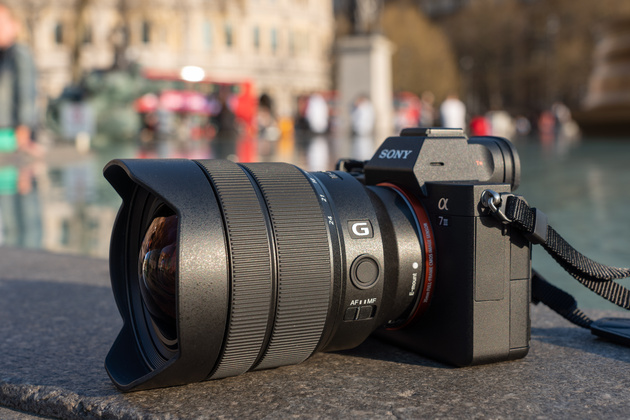
Let’s say right away that the wow effect from the announcement of each of the third-generation cameras was powerful. If the ILCE-7RM3 surprised with a combination of the highest characteristics, then the ILCE-7M3 amazed with the ratio of price and capabilities. Experienced photographers immediately saw in its specifications an explosive mixture of two more expensive models - ILCE-7RM3 and ILCE-9 - with a significantly lower cost.
Has Sony really released a DSLR killer? Or is there some kind of catch hidden behind the impressive characteristics? We will find out this in our test.
The first Sony Alpha 7 III to arrive in Russia spent more than one day in the editorial office; we tested it in different shooting genres and took many beautiful shots. But before moving on to a detailed review, let's look at the camera again: what do the developers want to surprise us with?

Matrix. More than you expect
The heart of the camera is a full-frame 24-megapixel CMOS sensor. It would seem that everything is the same as in the Sony ILCE-7 and ILCE-7M2. Nothing stopped the developer from once again putting a well-proven sensor into the base camera of the series. But the three Latin letters BSI from the official description of the camera say more: a new back-illuminated matrix is used here. We have every reason to believe that this is practically the same sensor as used in the Sony A9, but without a layer of built-in memory (logical for the basic model of the line).
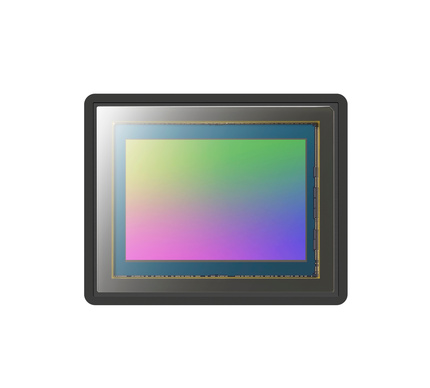
However, there should be no problems with speed. The sensor is used with the latest BIONZ X image processor and LSI (Line System Integrator) preprocessor. Thus, the reading speed is doubled and the data processing speed is increased by 1.8 times compared to the ILCE-7M2.

In-camera JPEG without processing
Working at high ISOs, naturally, was also inherited from its reporting counterpart, and not from the previous generation of “sevens”. This becomes clear literally after the first frames: the pictures make very little noise.
Gate
The youngest of the newest “sevens” can shoot up to 10 frames/s with both mechanical and electronic, absolutely silent shutter. Note that the manufacturer does not claim shooting without a rolling shutter (unlike the Sony A9). The reason is a “ordinary” and not a multilayer matrix.

In addition, in the comfortable Live View mode, when the photographer sees a live picture on the screen, and not the last frame of the series, you can shoot up to 8 frames/s. However, these restrictions cannot be considered significant. The stated buffer capacity is also impressive - 89 compressed or up to 40 uncompressed RAW files. This is clearly not an amateur level.
Autofocus for growth
For autofocus in the Sony Alpha 7 Mark III, a system of 693 phase focusing points located directly on the matrix is responsible. They cover 93% of the frame area - competitors could not even dream of this. The phase sensors are assisted by 425 contrast autofocus areas. Thus, the system is hybrid. And now the main “trifle”: we have before us the characteristics of the top-end Sony A9, only in a much more budget model.
The autofocus system has inherited the eye-targeting function (including in continuous mode), face recognition with a specified priority, and other fine settings. Autofocus sensitivity reaches EV-3, which is an impressive figure for modern cameras.

Stabilizer
Just in case, let us clarify that the well-proven image stabilizer based on matrix shift has not gone away. It is still capable of stabilizing camera vibrations in five axes, and also works in conjunction with the lens stabilizer. However, in the third series of “sevens” its efficiency was increased and is now stated at the level of 5 shutter speed levels.

4K from full frame
The ILCE-7M3 can shoot Full HD and 4K from the full width of the sensor. In full-frame mode, pixels are read completely and without combining (binning). This compresses approximately 2.4 times more data than is needed to record 4K (3840x2160) videos and reduces the moire effect. Bitrate is up to 100 Mbit/s.
Full HD shooting is possible at an increased frame rate of up to 100/120 fps. It also features a special S&Q fast and slow motion mode, which allows you to shoot Slow Motion and interval videos. In addition to the already familiar S-Log2 and S-Log3, HLG (Hybrid Log-Gamma) is supported for shooting in HDR.
Step forward in detail
Almost all the useful innovations that we noted in the ILCE-7RM3 test are also implemented in the ILCE-7M3. Of the most important, we note the touch interface, improved ergonomics, support for UHS-II memory cards and the larger NP-FZ100 battery. Among the simply pleasant things are two USB connectors (Type-C and traditional Micro-USB), charging and power supply from any USB, a flicker suppression function, and a photo rating system in the camera itself.

The camera screen has become touch-sensitive. It allows you not only to select the autofocus area with a touch, but also to move it with your thumb when viewing through the viewfinder. Unusual, but very convenient.
What did the developers sacrifice in pursuit of reducing the cost of the new product? A thorough study of the characteristics led to the following results. Compared to the ILCE-7RM3, the sensor resolution has decreased, the Pixel Shift mode has disappeared, and the viewfinder resolution has decreased from 3.6 to 2.3 million dots. Compared to ILCE-9, first of all, the shooting speed has dropped, the buffer volume and the speed of reading from the matrix have decreased. Otherwise, the developers managed to almost painlessly drag top-end features into the mid-price segment of cameras without serious marketing restrictions.
Sony a7 III. First review
Hello, friends. The promised review of the Sony a7III is live. As usual, biased, biased, full of dubious conclusions and idle speculation. That is, truthful.
In the English-speaking world there is such a concept - Wadsworth's axiom (The Wadsworth Constant). According to this axiom, you can safely skip the first 30% of any video on the Internet. Because at the beginning it’s always complete slag and nothing of substance. The same goes for most reviews and tests.
Therefore, to save your time, today I will not write a long 30% intro to the post. Instead, I'll write a small one, say three percent. And since it so happens that you have already read it, then you don’t need to skip anything further. Moreover, I will save you even more time and immediately announce the verdict.
Pros
• Very good camera.
• Can do everything.
• Made for everyone.
Cons
• Except me.
Verdict
On the one hand, I don't really like Sony. It so happens that we have few common values. On the other hand, it looks like DSLR cameras have already packed their bags and are ready to go to the beautiful far away, following the dinosaurs. But we haven't left yet.
Next, if you are still interested, is the review itself.
Paradigm, abstraction, perspective
Reading posts like this, we subconsciously ask ourselves the same questions: “Who writes this?” and “Are we alike?” Without answering them, no benefit can be derived from what is written.
So who am I? What is my contribution to a civilization rushing towards collapse? My life offers no answers. At the same time, I often photograph what I see. Why is not known exactly, but it happens naturally.
What do I take photos with? - Everyone. Even by phone. It sounds crazy, but for me it is the simplest tool with which everything comes out imperfect and with room for interpretation, approximately the way I feel.
What does this have to do with full-fledged cameras? - In general, it has nothing to do with it. For me, cameras have paradoxically little connection with photography. They are about something else - about technology, design, engineering, ethics and commerce. Cameras are material objects of human culture. I have an anthropological interest in them.
A more advanced camera may be more likely to make my photography worse or more difficult. However, I'm willing to use it out of curiosity. I'm interested in who made it, how and why. And also what I will do with it and what sensations it will make me feel.
This is the starting point.
Camera and lenses
So. Today I am holding a Sony a7III with a Sony Zeiss FE 50mm f1.4 ZA Planar T* lens. In addition, I have a Metabones IV generation adapter from Canon to Sony and a bunch of different lenses for Canon. I will test them with them.
A small digression about lenses: sometimes friends and strangers ask me to recommend an inexpensive lens for Canon / Sony / Fuji, etc. And I flinch every time. Mainly because this is asked by a person who has a phone in his pocket that takes better pictures than a Cartier-Bresson camera. And instead of going and shooting better than Bresson, he asks about some lenses.
So the review seems to be about the camera, however, the pictures that you will see next are mainly formed by the design of the selected lenses and only partly by the camera. And also partly with Tilda’s burning compression.
Design
The body of the a7III has improved compared to previous Sonys. More comfortable handle, nicer textured plastic. Buttons are easier to reach.
You no longer need to be a seasoned proctologist to be able to press the Menu button. Which, however, is not such good news due to some of the properties of this menu, but more about them below.
The overall aesthetic of the camera is still very formal, with no love for the product or the person. Sonya either did not have enough strength and attention, or simply did not understand that thoughtful details could be important to someone.
Why does the C4 button have an icon on the button, and “C4” is written next to it, but the C3 button has the opposite: the icon is next to it, and “C3” is written on the button?

Actually, I think I know why. And I don’t like them for this in advance. But this is a topic for a separate essay about bad design and the convoluted train of thought in the heads of those who make it.
I also cannot forgive these people for the permanent marketing inscriptions on the camera and the general bad taste.
The entire camera is densely covered with ugly labels: “4K”, “SteadyShot inside”, “T*”, “Wi-Fi”, “NFC”. — Why does a photographer need this visual slag? Why does my mind have to filter out the meaningless, useless and ugly every day for £2k? It's not clear at all. Sony's president, by design, blushes, sweats, and bows guiltily in response. But he doesn’t do hara-kiri.

Despite all the wealth of unnecessary inscriptions, the necessary port covers are not labeled. All the paint and diligence went into the labels.
Where should I charge it? Where to put HDMI? You have three chances to guess:

The mode dial continues the excursion into the world of functional helplessness. I don’t know who started it first, but brands still put it on their cameras simply because everyone else is doing it too. Kamon, dudes! The 21st century has arrived! Attach this disc to your nose and walk around with it.
And also the antique exposure compensation dial is generally a glitch in the universe on this particular camera. It is tight, uncomfortable, unpleasant and the exposure compensation is displayed on the screen with a horse lag.
Also, what it shows doesn’t necessarily correspond to what it really is. Because you can set the dial to +2, and then set the exposure compensation through the menu to –3. We end up with a camera whose correction dial shows +2, but the correction is actually –3.
And it's not fatal. You can live with this knowledge, and you can still shoot with your camera. However, if we put aside false political correctness, we must admit that the person who allowed this to happen in a commercial product is an idiot and should be fired.
All this is rarely written about in reviews, because most reviews are also written by idiots, but the entire Sony a7III is full of such blunders and inconsistencies. It's just a very bad product with some good features. Paradox.
Picture quality
Formally very good. Most likely, this is now one of the best sensors on the market in terms of noise, detail and shooting in the dark.
However, in terms of colors and simply aesthetics, the picture looks a bit rough after Canon or Leica. Colors in the middle of the range are more or less ok, but in the shadows they are depleted and overcooked. The skin and wood tones are generally quite bad, more on them below.
This is a straight chamber burner with neutral settings:

Despite the declared broad DD, Sonya’s picture is focused on the main engine of capitalism - the Chinese provincial tradesman gathered on a tour trip. Therefore, in color and contrast, it resembles a vinyl tablecloth from our hero’s favorite noodle shop in Guangzhou. Plastic green, everything light is embossed almost white, the flowers scream for help so much that they drown out everything around. But it's bright.
The watering can is also not without its quirks, but at least it doesn’t scream or kick me in the forehead from a running start. And, on a calibrated screen, the colors are much closer to what I see with my eyes. For which I thank him.
All this applies to RAW as well. Sony has the same game there, if it’s not a global conspiracy of Adobe and Phase One who created deliberately hellish profiles for the a7III.
Skin tones
Reproducing the shades of human skin is not possible for the Sony company. Slipping away from her. Like the art of clear speech from Leonid Ilyich in his declining years.
Sony a7III is no exception. The skin tone is much worse than that of the roommates. Did you see the table in the example above? She also renders skin tones in the shadows.
Below is an example, this is ISO 8000, however, look at the forehead, how few shades there are in the shadows and what fraction of the gray-blue-green color there is. It is visible everywhere, regardless of settings and software. Treatable in post-processing, for example with some RNI film profiles. I've never had to struggle this much with any other camera, even at the same high ISOs.

Menu
If you, God forbid, are a designer, and if life and sanity are dear to you, then you should not buy this camera under any circumstances.
At first everything will be the same for you. But then, one not-so-wonderful day, you discover that your salary has been reduced. And your colleagues look at you strangely. And you are no longer invited to the Winery to give lectures, and in general, the very fabric of life seems to have shrunk and shrunk.
And it's all about the magic camera you recently bought. It turns out that there is a menu, and it has an unusually nasty font. This is not even Helvetica, but something faceless based on its motives, compressed from the sides. Not a condensed style, but the font was directly compressed and compressed. So the vertical stick at “T” became 3 pixels, and the horizontal one 4. And some of the icons were shrunk.
In some Asian cultures, where writing is hieroglyphic, people are very free with the proportions of graphics and type. They can shrink or stretch the photo in the ad, as long as it fits. All the same, this is a kind of convention, a symbol.
And, if you are not an Asian designer and you do not have immunity, then you look at this menu day after day, and it registers in your mind as something acceptable, as a little unsightly, but still part of the norm. Well, yes, well, they squeezed it a little, it’s a little ugly, but it’s still clear, what’s wrong here? And it is from this quantum of acceptance, a small act of non-resistance to great evil, that the fall begins. When the designer picks up the Sony a7III and presses the Menu button, a small, 3-4-inch portal to hell opens in his hands. Moreover, hell for all of us. This is a designer, he is now looking at the menu, and in five minutes he is creating for the masses.
Luckily, I'm no longer a designer, and in my hands this menu isn't that dangerous. However, even I prefer not to open it unless absolutely necessary. And when I open it, I protect myself from it with one mental trick or another: I convince myself that this camera is not mine, but Aunt Xiaomin’s, that she is infinitely kind and carefree, may the mercy of heaven be with her, and that everything will pass, and that when the menu is closed , then it is not there.
Sony a7 mark III – love through tears. Test
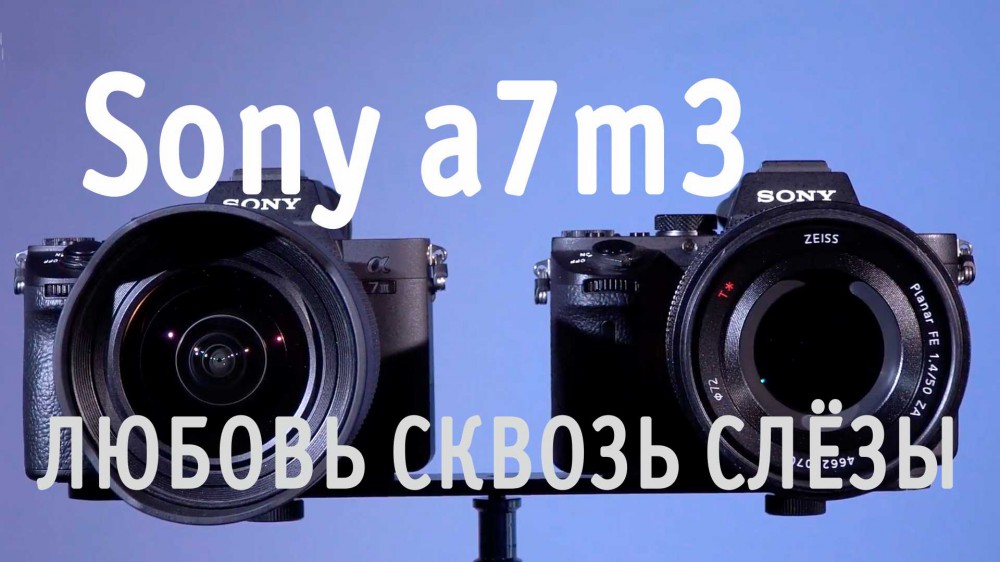
Today I will try to conduct an unbiased test of the Sony a7 mark 3 camera, which everyone has been vying with in praise lately. I will list the pros and cons that I personally noted for myself.
Now about the camera
Regarding appearance, the Sony a7 mark III, like the Sony a7R mark III, acquired a more massive grip, a joystick, a second memory card slot and a USB C slot. The button layout also changed compared to the previous model and the camera received a larger battery (like Sony a7R mark III).

The menu is also largely similar, although some customization options have been removed. This camera does not have the ability to install applications, which means you won’t see Time lapse. I took this move very aggressively, since a mirrorless camera without the ability to program interval shooting directly in the body is a step backwards. And knowing that this was done intentionally, you want to tear and throw.
I won’t praise this camera, because everyone who is not too lazy has already done this, but for some reason they tactfully kept silent about the disadvantages, but they exist (in addition to the above-mentioned “maneuver” in the menu). Although overall the camera is really good.

Continuous shooting
The first disappointment was the continuous shooting. 30% defocused frames is the minimum that I got both in illuminated areas on the street and in the shadows with a fixed lens on the body. But I'm not much of a runner. If there are lighter areas behind you, then the focus blurs to the right and left. In general, this camera is not for sports photography.
Rolling shutter
Rolling Shutter is weak here both at FHD and at 4K.
Sensitivity
For photos, the working ISO range can be safely considered to be 5000-6400 and even 12800 for a post in the same VK.
But for video everything is not so ideal.
Both in the old and in the new model, ISO 12800 is undesirable even in 4K, where the noise is finer. For fans of the S-log3 profile, such ISO values are simply unworkable, both on FHD and 4K.
But on a blindingly sunny day, this profile will be very appropriate up to a value of 3200 and even 6400 at 4K.
An interesting observation: if you compare the old model and the new one under identical lighting conditions, increase the ISO, leave the shutter speed unchanged, and adjust the exposure to level “0” only with the aperture, then the new product with an increase in ISO requires a more open aperture than the previous model. For example, with the light source unchanged, exposure “0” had the following values: Sony a7 Mark II (ISO 500, 1/100, f/4), Sony a7 Mark III (ISO 500, 1/100, f/4). And for the finale, this is what came out: Sony a7 Mark II (ISO 8000, 1/160, f/16), Sony a7 Mark III (ISO 8000, 1/100, f/13). That is, the new product receives light worse on the matrix.
Otherwise, the camera performed very well, but it is by no means the “cheap” ideal that they try to present it as. There are both pros and cons.
Camera cons:
- location of the video recording button
- continuous shooting
- autofocus
- matrix sensitivity to light
- small buffer
- long loading preview
- incorrect spectrum of blue color (deviations towards violet)
- inability to install applications.
Pros:
- battery
- dual memory card slot
- ergonomics
- focusing by eyes
- dynamic range
- low noise at high ISO
- sharpness (using the optics provided to us)
- video shooting (weak Rolling Shutter, good DD, working ISO up to 6400)
- price
- touch screen
- abundance of menu functions (not counting those intentionally removed)
- weather protection.
Test RAW images taken on Sony a7 mark 3 and Sony a7 mark 2 cameras (438 MB), download
Sony Alpha ILCE-7M3 4K at a competitive price
The Sony A7 3 is the new entry in the lower tier of cameras in Sony's full-frame 35mm mirrorless segment. The Sony 7 Mark III offers many of the latest photo/video processing techniques. This includes a first-time 24.2MP back-illuminated Exmor R CMOS sensor, ISO sensitivity limits of 50-204800, 15-stop dynamic range, 4K video with full pixel coverage, 10-frame continuous shooting, 5-axis frame stabilization with 5 steps, a 693-point autofocus system that controls 93% of the image area, an automatic aiming mode for the subject's eyes, a joystick for controlling the focus point and a best-in-class battery with a reserve of 710 shots. It is also worth considering that this camera is lower in rank than the A9, A7R III and A7S II. Let's take a closer look at its characteristics in the upcoming review of the Sony A7 3.
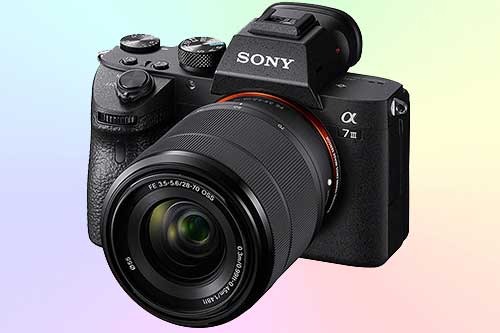
Sony A7 III review
Featuring 4K video downsampled from 6K and captured from the full sensor area, Sony's new 7III offers some incredibly compelling features and functions that are sure to give some pretty well-equipped cameras a run for their money.
It's fair to say that the α7 series is now practically legendary. Each version offers best-in-class capabilities for its time. Especially the S variations, which have become known for their low-light capabilities.
Peculiarities
• 24.2-megapixel CMOS sensor
• ISO 100-204800
• Burst shooting at 10 frames/sec
• Tilt touch screen
• 5-axis built-in stabilization
• 4K video recording
Full frame sensor
At the heart of the Sony A7 III is an all-new full-frame back-illuminated Exmor R CMOS sensor with 24 million pixels on board, which in its extended ISO mode offers a range of 50 to 204800. Sony also claims 15 stops of dynamic range, although and at lower sensitivity. This appears to be 1.5 stops better than the previous A7 II model.
This is theoretical. In practice, the way 4K video is captured is attractive. The camera reads the image from the entire sensor surface without combining (binning) pixels. In fact, the camera receives 4K video footage using downscaling from almost 6K images without cropping the frame. Needless to say, this provides quite decent video quality.
Recording proxy files is another feature that provides flexibility when working with footage in video editors (small proxy files are edited first, and replaced with large originals before export). There are no details yet on whether the footage is shot in 8-bit or 10-bit, but it is assumed that the 7III camera remains in the 8-bit region.

Autofocus speed and performance
Sony's innovative full-frame mirrorless A7 III has noticeably improved AF performance compared to the A7 II, including the addition of 4D FOCUS. The presented model of the lower line has 425 contrast focusing points, which interact with the 693-point phase system in the focal plane, borrowed from the famous A9 model. This advanced autofocus system covers approximately 93% of the frame, delivering reliable sharpness and tracking of even the most unpredictable subjects.
The new product can also be said to have radically improved the speed and response of AF. The focusing speed in low light has increased almost 2 times and tracking has been 2 times faster, if we talk about its predecessors. This was achieved as a result of faster reading of the flow from the matrix, which made it possible to capture complex and extraordinary movement with much greater accuracy.
The familiar Eye AF function is also present in the “fresh” camera, and in AF-C mode, which is sure to come in handy in situations where the subject is spinning, tilting, or otherwise making focusing difficult. It also works when the Sony Alpha A7 Mark III is mounted with Sony A-mount lenses with an LA-EA3 additive adapter.
Plus, the presence of a multi-selector or “joystick” to adequately move the focusing points also improves focusing flexibility, as does the presence of touch capabilities, AF functionality when the focusing magnifier is turned on, the “AF On” button and much more.

Signal processing speed
The Sony A7 III camera features an updated sensor flow signal processing system, which provides a burst of frames at maximum resolution and 10 fps with continuous, almost instantaneous and error-free focus and exposure tracking for up to 177 standard JPEG images, 89 compressed RAW images or 40 uncompressed images RAW frames.
This high-speed mode works with either a mechanical shutter or a completely silent electronic shutter, giving the camera additional flexibility. The device can also take pictures continuously at 8 frames/sec in Live View (real-time viewing mode) with a low lag of output to the viewfinder or LCD monitor.
To increase comfort, many of the camera’s functional buttons are also controlled during the process of dumping large batches of pictures/videos onto the card, i.e. It is possible to work with the “Fn” and “Menu” buttons, view images and certain other parameters.
In addition, if the shooting environment is artificially lit, photographers can use the Anti-flicker function, which allows the Sony A7 3 to automatically calculate the frequency of light flicker and adjust the shutter timing, which will reduce its impact on photos to virtually nothing. This in turn minimizes any exposure or color anomalies that can sometimes occur in the top and bottom areas of photographs taken at slow shutter speeds.
High quality 4K video
The newly-made Sony A7 3 is, among other things, an extraordinary video camera that provides 4K video recording (3840 × 2160 pixels) from the entire number of photo sites with a full-frame matrix. In video mode, the device uses total readout without pixel binning technology, collecting almost 2.4 times the amount of data required for 4K content, and then resampling it to produce 4K frames with unmatched detail and depth.
The HLG (Hybrid Log-Gamma) picture profile, which supports the Instant HDR workflow, is also included in the list of solutions on the Sony Alpha 7 III, allowing HDR (HLG)-enabled TVs to display beautiful, true 4K HDR footage.
In addition, both S-Log2 and S-Log3 are available to provide the user with color grading flexibility, as well as Zebra function and Gamma Display support. It is also possible to record Full HD at a speed of 120 frames/sec with a bitrate of up to 100 MBit/s, view video materials and, as a result, create 4x or 5x slow-motion Full HD video with AF tracking.

Design and settings
Sony's launch-ready full-frame camera comes with a decent variety of features that were first introduced in the A9 and then repeated in the 7R III. These include two slots for multimedia, with support for UHS-II type SD cards in one of the slots. We have a variety of storage options for each medium, including self-recording JPEG/RAW, photo/video recording, broadcast recording and more.
Battery life has also been significantly extended - according to CIPA measurements, up to 710 shots per battery charge. This is the world's longest "life" of any mirrorless camera, as it uses a Z-series NP-FZ100 battery with a capacity 2.2 times greater than the capacity of the W-series NP-FW50 battery, which costs 7 II.
The new camera features a My Menu feature that lets you define up to 30 menu items for instant recall whenever needed. Users can also apply star ratings to their photos for easier viewing/searching of images and edit the leading three characters of all photo files.
In addition, there are 81 functions that can be assigned to 11 customizable buttons. In addition to all this, the camera is resistant to dust and moisture. The Sony A7 III features a high-contrast, high-speed XGA OLED Tru-Finder with approximately 2.3 million dots of resolution. Standard and enhanced image quality settings are available for both the viewfinder and LCD monitor.
The camera can easily share files with smartphones, computers or FTP servers via Wi-Fi, and also has a SuperSpeed USB (USB 3.1 Gen 1) Type-C connector for increased power flexibility and faster image transfer while shooting through other gadgets.
The A7 III also comes with Sony's new Imaging Edge software, which enhances the creative possibilities of the entire shooting process, from pre- to post-production. Imaging Edge includes three PC applications called Remote, Viewer and Edit.
All are available for free download and support remote PC shooting and RAW processing. The latest version 1.1 brings several improvements, including an approximately 10% increase in data transfer speed for remote PC shooting and an approximately 65% improvement in responsiveness for RAW image editing.
The camera works with a wide variety of Sony E-mount accessories, including the BC-QZ1 charger and the VG-C3EM vertical grip.
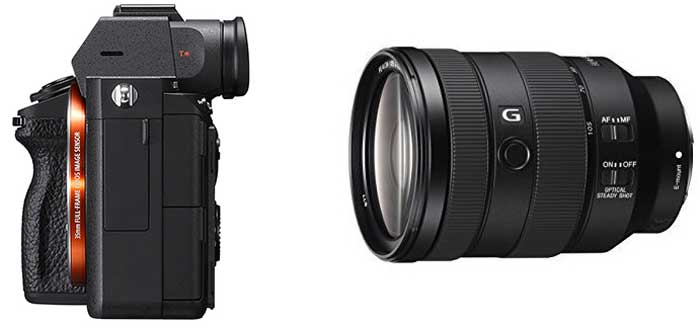
Specifications Sony A7 3
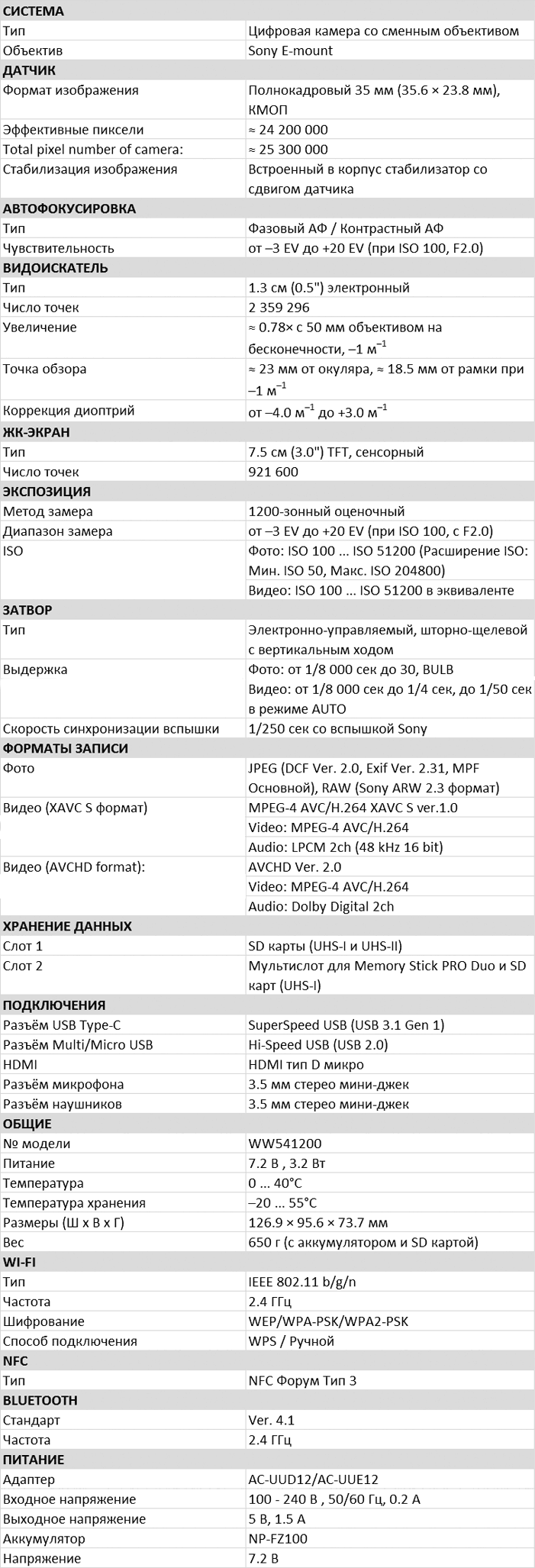
A7 III Price
The new Sony Alpha A7 Mark III camera will be available for purchase in Europe in March 2018 at a price of about 2300 euros (body only) or 2500 euros complete with the SEL2870 lens. Overseas they promise to start sales on April 10 this year.
Review results
Summing up the review of the A7 III from Sony, we note the advantages of the camera over its predecessors. Although the A7III has a lower sensor resolution than the α7RIII, the new camera is more light-sensitive, most likely due to its larger photocells. For those more interested in video mode, it's worth noting that the α7III reads the full sensor before downsampling.
This means that if you want to keep the full-frame video size, then this particular new product will be of interest for this. Finally, the new camera is 1000 euros cheaper. This is probably the most compelling reason to buy, especially if you don't need 42MP resolution.
The Sony Alpha ILCE-7M3 looks like a pretty nice upgrade over the old model. This is a camera that allows you to record high quality 4K videos. Not just a passable video, but material that is truly suitable for post-processing and can easily be displayed on a TV screen. So I think this will be a worthy purchase.
Sony A7R Mark III Quick Review - First Look at Sony's Updated Mirrorless Camera

Sony recently introduced a new model in its A7 series of mirrorless cameras - the Sony A7R Mark III, costing $3,200 (187,000 rubles). Like the previous A7R Mark II, the new A7R Mark III is clearly aimed at professional users.

Sony A7R Mark III design and specifications
The appearance, layout of controls and menus on the A7R Mark III will be familiar to all owners of the Sony Alpha A7 and A9. Sony created an interesting design for its second generation cameras and continues to do so in the third. The most noticeable updates are that the menu now has a little more options, and a joystick has appeared on the rear panel.

Although the Sony A7R Mark III uses the same 42.4-megapixel full-frame sensor, the hardware has been completely redesigned. A new autofocus system has been added, image stabilization has been improved, and the shooting speed has become much higher and is now 10 frames per second.
The battery has also become 2.2 times more durable - this is a significant advantage of the Mark III over other Sony mirrorless cameras. After 3 hours of use, with continuous shooting at 10 fps and recording 4K video, the battery was discharged to 40%, during which time I managed to fill up the 64 GB SD card. There are also two SD card slots, but only one of them supports the high-speed UHS-II standard.

But despite the improved battery life, the new Mark III lags behind professional-grade DSLRs, which offer 2x more exposures per charge.
In-body (5.5 stops)
| Index | Sony a7R III | Nikon D850 | Sony a7R II | Canon EOS 5DS R | Pentax K-1 |
| Price | 3200 $ | 3300 $ | 3200 $ | 3900 $ | 1800 $ |
| Number of MP | 42.4 MP | 45.7 MP | 42.4 MP | 50 MP | 36 MP |
| Sensor type | BSI-CMOS | BSI-CMOS | BSI-CMOS | CMOS | CMOS |
| ISO range | 100-32000 | 64-25600 | 100-25600 | 100-6400 | 100-204800 |
| Stabilization | Lens-only | In-body (4.5 stops) | Lens-only | In-body (5 stops) | |
| AF working range | –3EV (@F2) | –4EV | –2EV (@F2) | –2EV | –3EV |
| Magnification and viewfinder | 0.78x23mm _ |
0.75x17mm _ |
0.78x23mm _ |
0.71x21mm _ |
0.70x 21.7mm |
| Connections | Wi-Fi, BT (+NFC) | Wi-Fi, BT | Wi-Fi (+NFC) | Optional SD Card | WiFi |
| Shooting video | 4K/30p 1080/120p | 4K/30p | 4K/30p 1080/120p | 1080/60p | 1080/30p |
| Microphone/Connection | Yes Yes | Yes Yes | Yes Yes | Not really | Yes Yes |
| Flash speed | 1 / 250 | 1 / 250 | 1 / 250 | 1 / 200 | 1 / 200 |
| Flash socket | Yes | Yes | No | Yes | Yes |
| Continuous shooting | 20 fps | 7 fps | 5 fps | 5.0 fps | 4.4 fps |
| Intervalometer | No | Yes | Via the app | Yes | Yes |
| Memory cards | SD (UHS-II) SD (UHS-I) | XQD SD (UHS-II) | 1x SD (UHS-I) | CF (UDMA) SD (UHS-I) | 2x SD (UHS-I) |
| USB (connectors) | 3.1 (C) 2.0 (micro B) | 3.0 (micro B) | 2.0 (micro B) | 3.0 (micro B) | 2.0 (micro B) |
| Battery life (CIPA) VF/LCD | 530 / 650 | 1840 / — | 290 / 340 | 700 / 200 | 760 / — |
| Weight | 657 g (23.2 oz) | 1005 g (35.5 oz) | 625 g (22.0 oz) | 930 g (32.8 oz) | 1010 g (35.6 oz) |
For the new camera, Sony has released a new lens costing 1299 (RUB 76,000) - FE 24-105mm with a constant f/4 aperture and optical image stabilization. Weighing 0.66kg, it is the lightest full-frame 24-105mm f/4 lens, approximately 0.23kg lighter than Canon's equivalent.
Camera performance

One of the A7R Mark III's most useful features is Eye AF, which when turned on, the camera detects the subject's eyes and sets the focus window directly to them. The results are amazing.
The 24mm focal length produces excellent cityscapes, and the 105mm produces excellent portraits, although the f/4 aperture provides a very shallow depth of field.
Continuous shooting at 10 frames per second (faster than the A9) is especially useful when you need to capture moving subjects. Thanks to the combination of high speed and a new autofocus system, it is possible to achieve impressive quality of the resulting materials.

The 42.4 MP Sony A7R Mark III takes time to save files to the memory card, but menu navigation remains accessible - unlike previous versions of Sony A7 cameras, which had to wait. If you enable saving images as compressed RAW files during burst shooting, the depth of field will be limited to 12-bit. In this case, you can take individual 14-bit photos.



Shooting video
The reading speed has increased, which has reduced the effect of line-by-line image transfer. However, the Mark III is still far from the level of the A9 with a special anti-distortion shutter from Sony.

Colors and sharpness are excellent, with improved quality in Full Frame and Super35 modes. Many of the improvements will go unnoticed by amateurs, but professionals will be pleased.
The Sony A7R Mark III gets the latest version of S-Log3, capturing a wider dynamic range than the old S-Log2 on the Mark II. Hybrid Log Gamma (HLG) format is supported, which allows cinematic shooting in standard and high dynamic range simultaneously.
Sony A7R Mark III Sensor Shift Technology
Another key feature of the A7R Mark III is Pixel Shift Multi Shooting. In its principle, it resembles the High Res Shot mode on Olympus cameras and Pixel Shift Resolution on some Pentax DSLRs.
If a tripod is needed, the Mark III can take 4 shots in sequence, using sensor shift stabilization to change the sensor position by one pixel in each frame. This is especially useful if you are photographing small patterns and want to avoid the moire effect. However, special software is required to combine images into one photo.

Sony unveiled the A7R Mark III as its fastest, groundbreaking camera yet, bringing several world-first features. This may not be the case, but the Sony A7R Mark III is a great update to Sony's camera line-up, with many key features improved.

- 42.4 MP full frame sensor
- Continuous shooting at 10 fps
- Long lasting battery
- Improved image stabilization
- High AF performance
Advantages of Sony A7R Mark III
Disadvantages of the A7R Mark III
- No anti-distortion shutter
- RAW images are limited to 12-bit depth
Updated Sony A7R Mark III camera - video trailer
Review of the Sony A7 Mark III camera by Pavel Molchanov
In mid-April, I received a new Sony A7 Mark III camera for testing. Following the established tradition, I tried to try the camera in several genres, namely travel photography and portrait photography (including in the studio). I was still unable to decide on the class to which the camera could be classified (somewhere it is positioned as a camera for amateurs, but the functionality does not allow me to make such a statement). So, let's look at the main, and in my opinion, important characteristics.
 @ Pavel Molchanov
@ Pavel Molchanov
The first thing I pay attention to now is the resolution and dynamic capabilities of the sensor. The Sony A7 Mark III features a 24.2 MP full-frame Exmor R™ CMOS sensor. On the one hand, this may not seem enough, but I assure you that even on an A0 print, the pictures will look excellent, and I won’t even talk about publishing them on the Internet (you can scribble the picture a lot). Since the sensor is new, it has an excellent dynamic range (according to the manufacturer, it is 15 steps, but you will see how it looks in real life), which is clearly visible even in jpeg files. By the way, this camera gave me complete confidence that travel (and not only) photos can be taken in jpeg format and not bother. Of course, for “special occasions”, it’s worth turning on RAW and enjoying how flexible it is in post-production. Speaking about jpeg, I can’t help but note a number of important points that pleasantly surprised me, namely the very neat and accurate automatic white balance (yes, yes, I shot in it all the time), color rendition in general, and natural display of shades skin, even in very difficult lighting conditions. All these points allow us to say that if you take shooting lightly (meaning its non-professional purpose), in most cases you will get a ready-to-print image in jpeg format, with beautiful color and natural dynamic range. This can be very useful for photographers shooting reports or scenes that require a large number of photos and little time to correct problems with color and light.
 Sony A7 Mk3 + SEL1635Z.
Sony A7 Mk3 + SEL1635Z. Settings: F4, ISO 160, 1/100 sec. In full resolution. © Pavel Molchanov Sony A7 Mk3 + SEL1635Z.
Settings: F4, ISO 160, 1/100 sec. In full resolution. © Pavel Molchanov Sony A7 Mk3 + SEL1635Z. Settings: F4, ISO 100, 1/125 sec. In full resolution. © Pavel Molchanov Sony A7 Mk3 + SEL1635Z.
Settings: F4, ISO 100, 1/125 sec. In full resolution. © Pavel Molchanov Sony A7 Mk3 + SEL1635Z. Settings: F4, ISO 100, 1/125 sec. In full resolution. © Pavel Molchanov Sony A7 Mk3 + SEL1635Z.
Settings: F4, ISO 100, 1/125 sec. In full resolution. © Pavel Molchanov Sony A7 Mk3 + SEL1635Z. Settings: F4, ISO 100, 1/200 sec. In full resolution. © Pavel Molchanov Sony A7 Mk3 + SEL1224G. Settings: F4, ISO 100, 1/125 sec. In full resolution. © Pavel Molchanov
Settings: F4, ISO 100, 1/200 sec. In full resolution. © Pavel Molchanov Sony A7 Mk3 + SEL1224G. Settings: F4, ISO 100, 1/125 sec. In full resolution. © Pavel Molchanov
The second point that cannot but worry is the camera’s performance at high ISO values (and in general the ISO range with which the camera can work). For the Sony A7 Mark III, the minimum setting is ISO 100, and the standard high setting is ISO 51200 (but the range can be extended from ISO 50 to ISO 204800 for photos). But what about life? For myself, I realized that when shooting scenes where detail is important, it is worth stopping at ISO 12800 (night landscape or architecture). And when shooting portraits (especially black and white), you can’t stop up to ISO 32000 (maybe more, it all depends on the level of artistry you want to achieve =) ). It seemed to me that noise begins to manifest itself negatively around ISO 3200-6400 (I repeat once again that this value does not lead to “terrible consequences” and a strong loss of detail). In general, the noise level will allow you to take beautiful pictures of both the city at night and people in low-light conditions.
 Sony A7 Mk3 + SEL1635Z.
Sony A7 Mk3 + SEL1635Z. Settings: F4, ISO 6400, 1/40 sec. In full resolution. © Pavel Molchanov Sony A7 Mk3 + SEL1635Z.
Settings: F4, ISO 6400, 1/40 sec. In full resolution. © Pavel Molchanov Sony A7 Mk3 + SEL1635Z. Settings: F4, ISO 6400, 1/40 sec. In full resolution. © Pavel Molchanov Sony A7 Mk3 + SEL70200GM.
Settings: F4, ISO 6400, 1/40 sec. In full resolution. © Pavel Molchanov Sony A7 Mk3 + SEL70200GM. Settings: F2.8, ISO 8000, 1/100 sec. In full resolution. © Pavel Molchanov Sony A7 Mk3 + SEL1635Z.
Settings: F2.8, ISO 8000, 1/100 sec. In full resolution. © Pavel Molchanov Sony A7 Mk3 + SEL1635Z. Settings: F4, ISO 12800, 1/40 sec. In full resolution. © Pavel Molchanov Sony A7 Mk3 + SEL70200GM.
Settings: F4, ISO 12800, 1/40 sec. In full resolution. © Pavel Molchanov Sony A7 Mk3 + SEL70200GM. Settings: F2.8, ISO 20,000, 1/100 sec. In full resolution. © Pavel Molchanov Sony A7 Mk3 + SEL70200GM.
Settings: F2.8, ISO 20,000, 1/100 sec. In full resolution. © Pavel Molchanov Sony A7 Mk3 + SEL70200GM. Settings: F2.8, ISO 25600, 1/40 sec. In full resolution. © Pavel Molchanov Sony A7 Mk3 + SEL70200GM. Settings: F2.8, ISO 25600, 1/40 sec. In full resolution. © Pavel Molchanov
Settings: F2.8, ISO 25600, 1/40 sec. In full resolution. © Pavel Molchanov Sony A7 Mk3 + SEL70200GM. Settings: F2.8, ISO 25600, 1/40 sec. In full resolution. © Pavel Molchanov
The third important parameter is the ability to quickly and accurately focus (and even better, dynamically track the subject). And here are the text characteristics of the camera: 693 phase focusing points, an additional 425 contrast autofocus points that cover 93% of the frame, autofocus performance is stated in very dark conditions, there is eye-priority focusing (including tracking). What does this mean in life? Focusing speed and accuracy are at the level of professional SLR cameras (as close as possible to them). Moreover, this applies to both scenes shot at wide/ultra-wide angles and portraits taken at 200 mm. I won’t hide the fact that I really liked how eye autofocus priority works. I previously treated such a function with great distrust, but it turned out that it was in vain. All portraits taken using this mode turned out sharp. I even went further and set the autofocus tracking to focus on the eyes, and again I got a very decent result.
 Sony A7 Mk3 + SEL70200GM.
Sony A7 Mk3 + SEL70200GM. Settings: F2.8, ISO 100, 1/250 sec. RAW. © Pavel Molchanov Sony A7 Mk3 + SEL70200GM.
Settings: F2.8, ISO 100, 1/250 sec. RAW. © Pavel Molchanov Sony A7 Mk3 + SEL70200GM. Settings: F2.8, ISO 100, 1/125 sec. RAW. © Pavel Molchanov Sony A7 Mk3 + SEL70200GM.
Settings: F2.8, ISO 100, 1/125 sec. RAW. © Pavel Molchanov Sony A7 Mk3 + SEL70200GM. Settings: F2.8, ISO 100, 1/400 sec. RAW. © Pavel Molchanov Sony A7 Mk3 + SEL70200GM.
Settings: F2.8, ISO 100, 1/400 sec. RAW. © Pavel Molchanov Sony A7 Mk3 + SEL70200GM. Settings: F2.8, ISO 100, 1/2500 sec. RAW. © Pavel Molchanov Sony A7 Mk3 + SEL70200GM.
Settings: F2.8, ISO 100, 1/2500 sec. RAW. © Pavel Molchanov Sony A7 Mk3 + SEL70200GM. Settings: F2.8, ISO 100, 1/2500 sec. RAW. © Pavel Molchanov Sony A7 Mk3 + SEL70200GM.
Settings: F2.8, ISO 100, 1/2500 sec. RAW. © Pavel Molchanov Sony A7 Mk3 + SEL70200GM. Settings: F2.8, ISO 400, 1/100 sec. RAW. © Pavel Molchanov Sony A7 Mk3 + SEL70200GM.
Settings: F2.8, ISO 400, 1/100 sec. RAW. © Pavel Molchanov Sony A7 Mk3 + SEL70200GM. Settings: F2.8, ISO 3200, 1/200 sec. RAW. © Pavel Molchanov Sony A7 Mk3 + SEL70200GM.
Settings: F2.8, ISO 3200, 1/200 sec. RAW. © Pavel Molchanov Sony A7 Mk3 + SEL70200GM. Settings: F2.8, ISO 3200, 1/200 sec. RAW. © Pavel Molchanov Sony A7 Mk3 + SEL70200GM.
Settings: F2.8, ISO 3200, 1/200 sec. RAW. © Pavel Molchanov Sony A7 Mk3 + SEL70200GM. Settings: F2.8, ISO 3200, 1/160 sec. RAW. © Pavel Molchanov Sony A7 Mk3 + SEL70200GM.
Settings: F2.8, ISO 3200, 1/160 sec. RAW. © Pavel Molchanov Sony A7 Mk3 + SEL70200GM. Settings: F2.8, ISO 1250, 1/160 sec. RAW. © Pavel Molchanov Sony A7 Mk3 + SEL70200GM.
Settings: F2.8, ISO 1250, 1/160 sec. RAW. © Pavel Molchanov Sony A7 Mk3 + SEL70200GM. Settings: F2.8, ISO 100, 1/200 sec. RAW. © Pavel Molchanov Sony A7 Mk3 + SEL70200GM.
Settings: F2.8, ISO 100, 1/200 sec. RAW. © Pavel Molchanov Sony A7 Mk3 + SEL70200GM. Settings: F2.8, ISO 3200, 1/125 sec. RAW. © Pavel Molchanov Sony A7 Mk3 + SEL70200GM.
Settings: F2.8, ISO 3200, 1/125 sec. RAW. © Pavel Molchanov Sony A7 Mk3 + SEL70200GM. Settings: F2.8, ISO 100, 1/125 sec. RAW. © Pavel Molchanov Sony A7 Mk3 + SEL70200GM.
Settings: F2.8, ISO 100, 1/125 sec. RAW. © Pavel Molchanov Sony A7 Mk3 + SEL70200GM. Settings: F2.8, ISO 3200, 1/125 sec. RAW. © Pavel Molchanov Sony A7 Mk3 + SEL70200GM. Settings: F2.8, ISO 3200, 1/125 sec. RAW. © Pavel Molchanov
Settings: F2.8, ISO 3200, 1/125 sec. RAW. © Pavel Molchanov Sony A7 Mk3 + SEL70200GM. Settings: F2.8, ISO 3200, 1/125 sec. RAW. © Pavel Molchanov
The speed of autofocus tracking along with continuous shooting is beyond praise, and as an example, just look at the pictures. An important addition is that the shooting was carried out at 200 mm and aperture 2.8 (for maximum complexity). Regarding the shooting speed, it should be noted that the camera is capable of taking 10 frames per second, which is far from an amateur indicator (do not forget that the number of frames per second depends on the set shutter speed, which, in turn, depends on the lighting).



